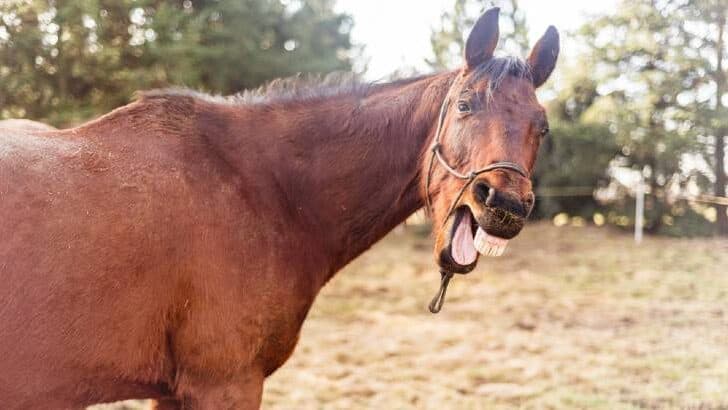Affiliate Disclaimer
As an Amazon Associate I earn from qualifying purchases. It helps me keep the website going. Thank you for your support.
What is ‘happiness’ for a horse and how can you tell if a horse is happy? As horse owners, we like to think our horses are happy and content. But are they? Fortunately, horses can usually be relied upon to let us know whether they’re happy, or unhappy! It’s just a case of knowing what to look for.
‘Horse happiness’ is probably best described as being a state in which its overall well-being needs are being met. This includes its physical, mental, and emotional health. Signs that a horse is happy can include a relaxed body posture and a willingness to interact with humans. It also includes an overall good attitude.
Conversely, horses that are stressed, anxious, or unhappy will exhibit signs such as extreme agitation, aggression, or depression. Therefore, it’s important to monitor your horse’s behavior and watch for any signs of distress.
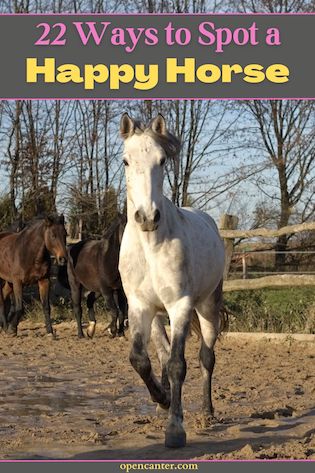
Key Ways to Tell if Your Horse is Happy
Here are 22 horse happiness indicators to help you tell if your horse is truly content.
#1) Watch The Ears
The position of a horse’s ears is often a very good indicator of the horse’s emotional state. They can indicate happiness, alertness, unhappiness, illness, and aggression.
When the ears are forward, the horse is alert and attentive. Floppy ears facing sideways and downwards (lop-ears) can be a sign of pain and discomfort. Ears pinned flat back against the head indicate the horse is feeling protective, defensive, or just downright aggressive.
When the ears are relaxed and slightly back, it usually indicates that the horse is content and happy. They will casually flick backward and forward in response to external stimuli. This is because even half asleep, horses are still monitoring their surroundings for potential danger.
#2) A Horse’s Eyes – A Good Way to Tell If a Horse is Happy
Look into my eyes… When horses are angry, upset, anxious, or scared, you can often spot it in their eyes. Their eyelids may open wide, for instance, exposing the white sclera around the iris and giving them that ‘wild-eyed’ look.
Their eyes also look tense and may appear to bulge in their sockets. The top eyelid often develops sharply angled wrinkles (worry wrinkles) as the underlying muscle contracts and tenses.
If the horse is happy, the eyes will be soft, calm, and relaxed. The eyelids may also be half closed and droopy, especially if they’re happily relaxing in familiar surroundings. The angle of the ‘worry wrinkles’ will be narrower because the underlying muscle is relaxed.
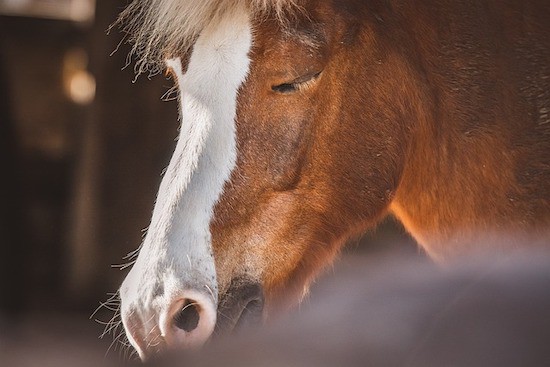
Incidentally, some horses naturally have visible white sclera. This is because it is associated with some coat pattern genes and large facial markings.
#3) Bottom Jaw – It’s Jaw-Dropping When A Horse Is Happy
A tense, set jaw is an indication of a tense, anxious horse. On the other hand…
When a horse is happily chilling, its bottom jaw relaxes, sometimes to the point of drooping open slightly. This in fact is one of the most obvious signs of equine contentment. The lower lip may also droop, and there is often a bit of dribble happening as well!
However, dribble can also be a sign of an abscess, bad tooth, or gum infection so monitor the dribble. If it has a strong odor or happens even when the horse isn’t relaxed, then contact your vet.
#4) Check Out The Muzzle
Your horse’s muzzle can tell you a lot about its feelings. A tight, wrinkled muzzle, pursed lips, and tense chin are sure signs the horse is stressed, anxious, or angry.
A happy horse will have a soft, relaxed muzzle and lips. When they’re extremely content, the lower lip often droops as well.
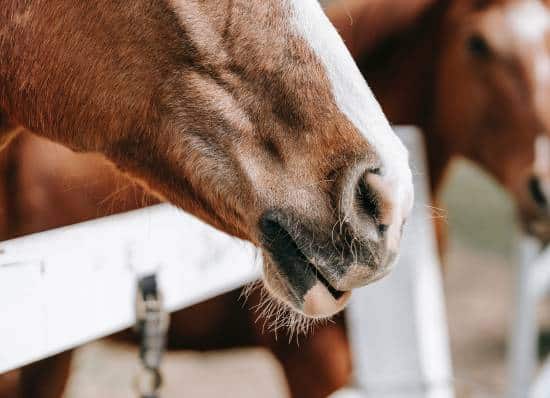
#5) Flared Nostrils – Are They A Way To Tell If Your Horse Is Happy?
Horses flare their nostrils for all sorts of reasons, including taking in more air whilst they’re exercising, and capturing scents. They also flare their nostrils to indicate excitement and anger, often snorting at the same time. Likewise, tense thin nostrils mean the horse is angry, aggressive, anxious, or uncomfortable.
If a horse is happy, its nostrils will be relaxed, rounded. The nostrils will flare gently in time with its equally relaxed breathing. They may also twitch slightly.
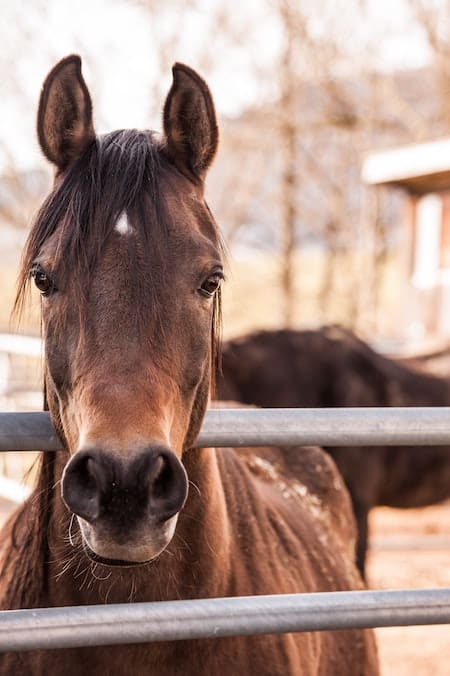
#6) Neck And Head Position
An upright, tense neck and head is a sign of tension, alertness, and readiness for action. Horses will also lower their heads and snake them from side to side to express aggression. This is usually accompanied by bared teeth, aggressive snorting, flattened ears, and thin flared nostrils.
It’s most often seen when horses are chasing or attacking something. Stallions also often exhibit this behavior when they’re challenging other stallions or trying to dominate a mare.
Therefore, you’re looking for a soft, extended, and relaxed neck with lowered head. This combination of features indicates a horse that is feeling content, relaxed, and happy.
#7) Muscles – And What They Indicate About A Horses State Of Happiness
Tense muscles, like humans, indicate a horse may be sore, anxious, on edge, stressed, angry…
Loose relaxed muscles however are a good indication that the horse is content, and happy.
#8) Your Horse’s Breathing
The way a horse is breathing is an important indicator of its overall health and well-being. A distressed horse, or one that is in pain, will often have an elevated breathing rate like it’s panting. It may also be breathing heavily or heaving as though it’s just worked hard.
A happy horse in contrast takes regular, slow, relaxed breaths. Every now and again they’ll take a deeper one, much like we do.
#) 9 Yawning, Chewing, and Sighing
A calm, relaxed horse is a happy horse! However, excessive yawning can also indicate teeth problems. Having said that, teeth problems will probably be accompanied by a sideways head tilt or other signs of oral discomfort.
Generally, though horses yawn, chew, and sigh to release muscle tension. So, if your horse does these a lot, it’s probably a good way to tell it is happy.
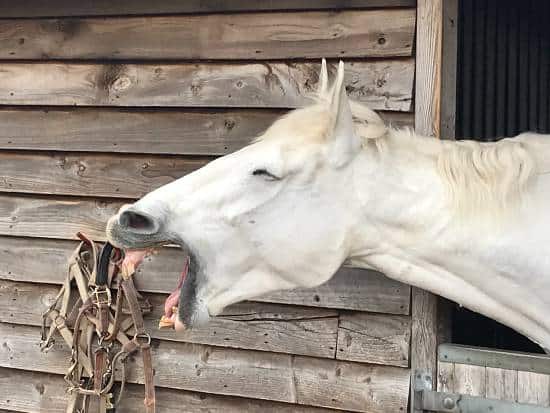
#10) Snorting – How To Tell If A Snort Is A Sign Of Equine Contentment
Snorting is one of a horse’s favorite means of communication. Recent research has found that horses snort a LOT more when they’re happy (source). However, there are snorts, and there are snorts. A horse snort can in fact mean a lot of things.
There’s aggressive snorting, which is a short, sharp warning whoosh from tense flared nostrils. This is usually directed at, or into, the face of the ‘opponent’.
Then there’s the ‘I’m excited’ snort, which sounds a lot like the aggressive snort except. The difference is that there will be a lot of other ‘I’m excited’ body language going on as well.
What you want in a happy horse is a softer snort with more relaxed nuances. The nostrils likewise should remain relaxed during a ‘happy’ snort. Soft rhythmic snorting when working is also a good indication that a horse is happy and relaxed in its work.
#11) Whinnying – Some Whinnies Mean A Horse Is Happy
Fun fact – a horse’s whinny, or neigh, often sounds very much like its dam’s whinny, particularly with mares! Horses whinny to express emotions or communicate with each other. Knowing the different types of whinnies can therefore be key to determining whether the horse is feeling happy, anxious, or aggressive.
An anxious whinny for example may have a stressed undertone or be higher pitched than normal. Stallions usually have higher-pitched whinnies than mares and geldings, and will often almost ‘scream’ when they’re feeling aggressive.
However, you can be pretty sure that if your horse whinnies when it sees you coming, particularly at feed time, it’s excited and happy to see you (largely because it knows it’s going to benefit in some way – get a treat, be fed, get let out/brought in, etc!)
#12) Nickering – Another Vocalisation That Shows a Horse Is Happy
Nickering is a softer more relaxed sound than a neigh or whinny. It’s also done with the mouth closed whereas neighing requires the mouth to be open.
Mares nicker to their foals as a natural part of mothering. Your horse may nicker at you as a sign of friendship and acceptance. It may also be telling you to hurry up and hand over the treat it knows you have!
In general, nickering is a sign of horse satisfaction and usually means the horse is feeling safe, happy, and comfortable.
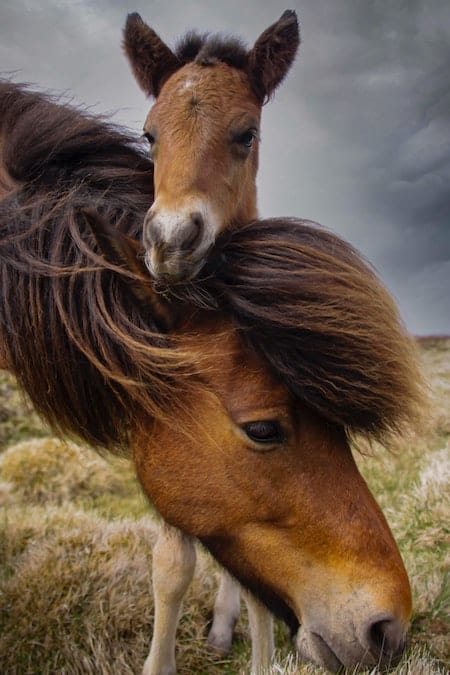
#13) Swishing Tails Can Indicate A Happy State Of Mind
Just like cats, and dogs, a swishing horse tail can tell you a lot about how the owner of the tail is feeling! Horses that are upset or angry will aggressively swish or wring their tails. Similarly, tail swishing while working, especially when being asked to change paces, is frequently a sign of soreness or overly enthusiastic aids from the rider. However…
A relaxed, idly swishing tail is a good sign the horse is content and happy.
#14) Resting Foot – Lame Or Just Happy?
You’ve probably noticed horses standing with a cocked or resting hind foot. Although this can be a sign of soreness, especially if the horse regularly only does it on one side, it’s also a sign of relaxation.
In fact, most horses will stand with one back foot cocked when they’re relaxed and happy, or sleeping. They should however regularly alternate between legs. So – if you notice your horse standing like this, and all its other horse happiness cues check out, it’s probably happy!
A resting front foot on the other hand is definitely a sign that something is amiss with that foot – abscess, sprain, or a hoof problem.
#15) Mutual Grooming – Happy Horses Love Doing This
Horse behavior such as mutual grooming is a sign of contentment and happiness and usually indicates the horses are comfortable in each other’s presence. It’s also indicative of mutual respect, trust, comfort, and companionship. Conversely, if one of the horses is not reciprocating the grooming, it may be a sign that the horse is not happy, and that the other one is trying to ‘comfort’ it.
Mutual grooming is a great sight to see, as it shows that the horses are happy and content in their environment.
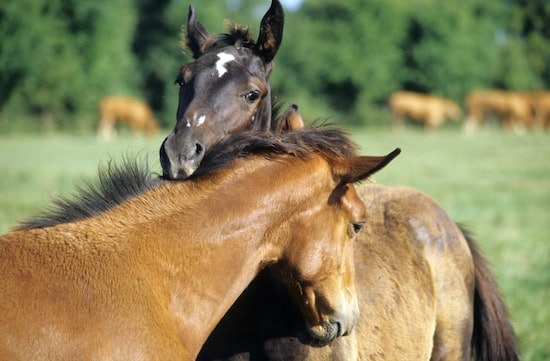
#16) Playing – A Playful Horse Is Usually A Happy Horse
Playing and frolicking are normal horse behaviors, particularly for young, healthy horses. Even if they’re on their own, they’ll usually cavort around, shying at imaginary things, bucking, prancing, snorting, and just generally having fun.
Sometimes it’s just a reaction to being let out of a confined space, like a stable or small yard. But even horses that spend most of their time in a paddock still enjoy having a good run around when they’re happy and content.
Normal playful behavior is a great way to tell that a horse is happy.
#17) Herd Behaviour – Telling If A Horse Is Happy By Its Herd Behaviour
Watching horses in a herd situation will give you some surprising insights into horse emotions. Unhappy or unwell horses often stand apart from the herd, whilst happy, content horses will be getting on with life as an integral part of the herd.
Horses that are happy in a herd situation are the ones grazing, playing, grooming each other, sleeping, and just generally going about normal life as a horse.
#18) Grazing Habits – What To Look For When A Horse Is Happy
Horses evolved to spend most of their time grazing. However, certain things can upset this natural habit, such as bad teeth, illness, depression, stress, anxiety… So, if your horse is surrounded by lush green (edible) grass but is ignoring it in favor of pacing along the fence, whinnying, and generally stressing out, that’s a sure sign it’s an unhappy horse.
Grazing contentedly, sharing a special grass patch with a friend, occasionally raising its head to cast a watchful eye over its surroundings, and generally being at peace with its environment, all indicate a horse is happy.
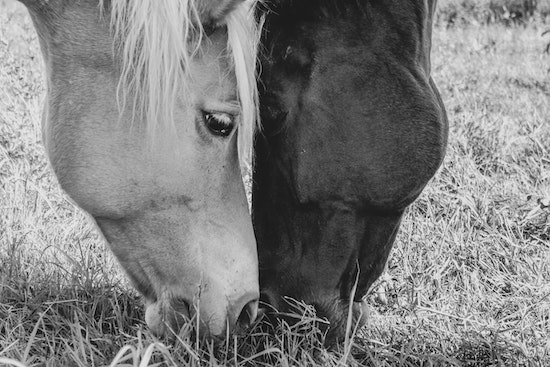
#19) Watch Your Horses Eating Habits
Healthy, happy horses love their feed and one of the quickest ways to pick up if they’re not well is when they’re not eating properly. They may have a bellyache (colic) or a dental or oral problem that makes eating painful. Either way, when your horse isn’t tucking into its hard feed or hay like it normally does, it’s a concerning sign.
When a horse is happy, it will have a consistent appetite, be keen to eat, eat regularly, and consume its full daily ration.
#20) Manure – What Your Horse’s Manure May Be Telling You
Healthy horses pass healthy manure at least 5 – 8 times a day. Passing manure is also a way of releasing tension. This is probably why they always do at least one in the horse float or truck when you’re taking them somewhere!
Runny manure however can indicate digestive issues such as worms or sand, as well as stress and tension. Very hard, dry manure is also not good because it often means the horse isn’t drinking enough for some reason (illness, stress) so is dehydrated.
Passing regular, healthy manure regularly is a good sign your horse is healthy, relaxed, eating well, and doesn’t have any serious digestive disorders happening i.e. it’s happy.
#21) Horse Bedding – Even This Can Tell You Something About Horse Happiness
If your horse suddenly starts turning its bedding or yard into a tip, something is up. Digging and pawing are signs of intense discomfort and may warrant a call to your vet depending on what’s causing the behavior. Pacing is a sign of stress and anxiety. None of them are indicators of a happy horse!
Horses typically relax at night, especially if they’re stabled or yarded. A horse that is feeling happy and safe doesn’t generally trash its bedding so, apart from some minor disturbances where it may have laid down and gotten up again, will have relatively smooth bedding.
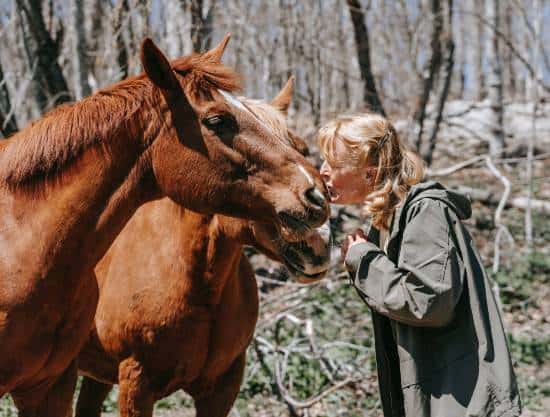
#22) Willing Interaction with People And Animals
Horses that are at ease around people and other animal species, and are comfortable being worked, are invariably happier horses than those that aren’t.
However, training also has a lot to do with this. In other words, a horse may still give off ‘happy vibes’ yet be unwilling to work or not want to cooperate because it’s not been taught to do so.
Final Thoughts
Watching horse body language will often tell you if a horse is happy. A happy horse has a relaxed posture, even when it’s working. At rest, it looks comfortable, often standing with its neck stretched, head lowered to around wither height, eyes relaxed or even half-closed, and the ears may be idly flicking back and forth as it monitors its surroundings.
When working, it is soft and responsive to the rider, may snort gently, pass manure, and generally remain calm and well-behaved.
You can generally tell a horse is happy when they enjoy interacting with people and other animals. They have good body condition with a shiny coat and healthy hooves. In addition to this, they are interested in what goes on around them without being stressed or anxious.

